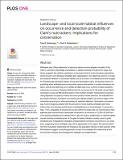Landscape-and local-scale habitat influences on occurrence and detection probability of Clark’s nutcrackers : Implications for conservation
Date
29/05/2020Metadata
Show full item recordAbstract
Whitebark pine (Pinus albicaulis), a keystone species and an obligate mutualist of the Clark’s nutcracker (Nucifraga columbiana), is rapidly declining throughout its range. Evidence suggests this decline is leading to a downward trend in local nutcracker populations, which would in-turn decrease whitebark pine regeneration. Our objectives were to (1) evaluate temporal variation in nutcracker habitat use as a function of whitebark pine and Douglas-fir (Pseudotsuga menziesii) habitat, at local and landscape scales, (2) develop metrics for predicting when whitebark pine communities require intervention to sustain nutcracker visitation, and (3) test McKinney et al. (2009) and Barringer et al.’s (2012) models predicting nutcracker occurrence. Between 2009 and 2013, we carried out 3,135 audio-visual Clark’s nutcracker surveys at 238 random points in the southern Greater Yellowstone Ecosystem. Using Bayesian occupancy models and cross-product model selection, we evaluated the association between nutcracker occurrence and habitat variables during five stages of the nutcracker annual cycle, while accounting for imperfect detection. Nutcracker occurrence was most strongly associated with the presence of cone-bearing whitebark pine trees (rather than cone density) and the area of whitebark pine on the landscape. To promote a high, >75%, probability of occurrence at a site within the study area, we recommend a management plan that achieves a landscape composed of a minimum of 12,500–25,000 ha of cone-bearing whitebark pine habitat within a 32.6 km radius. Additionally, an optimal habitat mosaic includes moderate levels of Douglas-fir habitat. Models currently used to guide whitebark pine management strategies underpredicted nutcracker occurrence in our study area, suggesting these strategies may not be appropriate in the region. We cannot predict how this mutualistic relationship will change as the population density of each species shifts. We therefore suggest conducting periodic surveys to re-evaluate the relationship as the environment changes and management strategies are implemented.
Citation
Schaming , T D & Sutherland , C S 2020 , ' Landscape-and local-scale habitat influences on occurrence and detection probability of Clark’s nutcrackers : Implications for conservation ' , PLoS ONE , vol. 15 , no. 5 , e0233726 . https://doi.org/10.1371/journal.pone.0233726
Publication
PLoS ONE
Status
Peer reviewed
ISSN
1932-6203Type
Journal article
Description
Funding: This study was generously funded by the Athena Fund of the Cornell Lab of Ornithology (www.birds.cornell.edu), Meg and Bert Raynes Wildlife Fund Research Grant (www.rayneswildlifefund.org)*, Cornell Lab of Ornithology (www.birds.cornell.edu), NASA Harriett G. Jenkins Pre-doctoral Fellowship (#NNX10AU20A, www.nasa.gov), Cornell Lab of Ornithology Kramer Graduate Fellowship (www.birds.cornell.edu), Cornell Lab of Ornithology Halberstadt Graduate Fellowship (www.birds.cornell.edu), Cornell University Research Travel Grant (www.cornell.edu), Cornell University Sigma Xi Grants-in-Aid of Research (www.sigmaxi.org), Cornell Lab of Ornithology Samuel and Linda Kramer Award (www.cornell.edu), Andrew W. Mellon Student Research Grant (www.mellon.org), American Ornithologists’ Union (www.aou.org), Mazamas Graduate Student Research Grant (www.mazamas.org), Conservation and Research Foundation Research Grant (http://conservationresearch.wordpress.com), Western Bird Banding Association Research Grant (www.westernbirdbanding.org), Wyoming Wildlife – The Foundation, Wyoming Community Foundation, Research Grant (# 20120167; www.wyomingwildlifefoundation.org)*, American Philosophical Society Lewis and Clark Fund (http://www.amphilsoc.org), The Garden Club of America Frances M. Peacock Scholarship (www.gcamerica.org), Charles Redd Center for Western Studies Summer Award for Upper Division and Graduate Students (https://reddcenter.byu.edu), Wilson Ornithological Society Paul A. Stewart Research Award (www.wilsonsociety.org), Explorers Club Exploration Fund (www.explorers.org), Fischer Equipment Grant (www.fischersports.com), and Havahart Equipment Grant (www.havahart.com).Collections
Items in the St Andrews Research Repository are protected by copyright, with all rights reserved, unless otherwise indicated.

